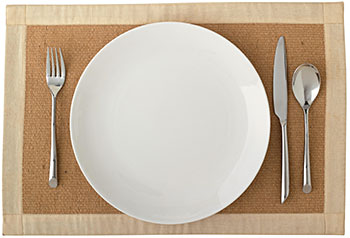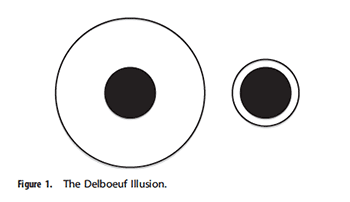More Health and Nutrition Bites
Related
Small Plates? Just a Myth
Just last month I reported on a study that concluded that children will eat more when presented with a larger amount of food (News Bite, 8/1/07). Another study seemed to show that using a larger bowl (or plate, presumably) would result in serving and eating more than if a regular-sized bowl is used (10/6/06
Prettier Tastes Better
Professional chefs agree: presentation matters. That's why you'll see them carefully arranging the food on the plate for best effect, then wiping off any drips or drabs that may fall on the edge of the plate.
Size Does Matter
Many diet plans and diet books for years have recommended using small plates to make it look like you are eating more. This concept was put to the test by two researchers, Brian Wansink and Matthew Cheney. In a research letter published by the Journal of the American Medical Association (JAMA Vol. 293 No. 14, April 13, 2005) they showed that the size of serving bowls makes a difference on the amount people eat.
Health & Nutrition Bites
Get the latest health and diet news - along with what you can do about it - sent to your Inbox once a week. Get Dr. Gourmet's Health and Nutrition Bites sent to you via email. Sign up now!
Fool yourself with plate design

Researchers have been experimenting with the plates we eat from for a while. Back in 2006 I told you about a study in which nutrition experts where given two different sizes of bowls and spoons and were invited to serve themselves ice cream. Even though they probably should have known better, those with the larger bowls and spoons served themselves more ice cream and ate more than those with the smaller bowls and spoons. If nutrition experts have trouble with portion size on oversize plates, it's not surprising that with standard dinner plates getting larger - about 36% larger, by some estimates (see Brian Wansink's Mindless Eating) - portion sizes are getting out of control.
Researchers at Stanford wondered if altering the design of the plate might not have an effect on perceived portion size. Take a look at the picture below:

The two dark inside circles are the same size, but the one on the right appears larger than the one on the left. This is what is known as The Delboeuf Illusion. Instead of black circles, what if the inner circles was food? Would portion sizes appear larger on smaller plates? What about borders on the plates - would that affect perception?
To find out, they recruited over 550 men and women to participate in two different online studies (Int J Obesity 2014;38(5):657-662). In the first experiment, the respondents were shown pictures of two different plates of food and asked to decide which portion of food was larger. This was repeated over 40 times, with the amount of food varying along with the design of the plate: no rim, or with one of 6 varying rim widths on a plate of the same size.
In a second experiment, the respondents again decided which portion size was larger, but this time the rim widths on the plates were the same while the decoration varied: from a single thin blue line around the outside edge of the plate to a solidly blue rim.
The researchers found that in the first experiment the respondents were 1 and a half times more likely to choose the plate with the widest rim as containing more food than the standard plate (remember that the amount of food was actually the same). In the second experiment, the participants were more likely to overestimate the amount of food when the plate had a rim decoration as opposed to a plain rim.
By analyzing the patterns of responses for each experiment, the researchers were able to determine that food on plates with wider rims appears about 10% larger than the same amount of food appears on a plate with a very thin rim. Similarly, food on plates with colored rims appears about 3% larger than it does on a plate with a plain rim.
What this means for you
You can use this knowledge to fool yourself into believing that you're eating a larger portion - and what's particularly cool is that you'll fool yourself even though you know it's an illusion (JAMA 2005;293(14):1727-1728). While I'm certainly not suggesting that you run out and buy a whole new set of plateware, but if you're working on your weight you might find it worthwhile to visit a thrift store to purchase a single set of rimmed and bordered plates for your own use.
First posted: May 14, 2014
